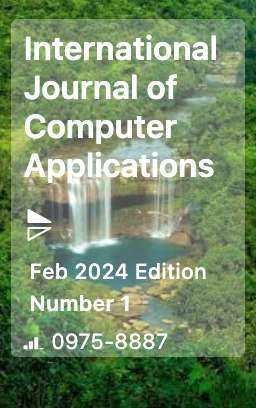Reseach Article
AI-Driven Solutions for Enhancing Cybersecurity in Healthcare Systems: A Comprehensive Review
| Journal of Advanced Artificial Intelligence |
| Foundation of Computer Science (FCS), NY, USA |
| Volume 1 - Number 7 |
| Year of Publication: 2025 |
| Authors: Thangaraj Petchiappan |
 10.5120/jaai202435
10.5120/jaai202435
|
Thangaraj Petchiappan . AI-Driven Solutions for Enhancing Cybersecurity in Healthcare Systems: A Comprehensive Review. Journal of Advanced Artificial Intelligence. 1, 7 ( Jun 2025), 1-8. DOI=10.5120/jaai202435
Abstract
As healthcare businesses face more and more cyber hazards as a result of digital technology's increasing integration into healthcare systems, cybersecurity is taking on more significance. This analysis looks at how AI may improve cybersecurity in the healthcare industry. AI technologies, such as ML, DL, and NLP, have become effective instruments for identifying, evaluating, and reducing cyber threats. The study demonstrates the efficacy of AI applications in cybersecurity, including automated incident response, anomaly detection, and predictive maintenance, in protecting sensitive patient data and guaranteeing the provision of essential healthcare services. Additionally, a paper discusses the regulatory frameworks that govern healthcare data security, including HIPAA and GDPR, which further emphasize the need for robust cybersecurity solutions. By exploring the current landscape of AI-driven cybersecurity challenges with solutions, this review aims to provide insights into best practices, emerging trends, and future directions for research and implementation in healthcare cybersecurity.
References
- A. L. Buczak and E. Guven, “A Survey of Data Mining and Machine Learning Methods for Cyber Security Intrusion Detection,” IEEE Commun. Surv. Tutorials, 2016, doi: 10.1109/COMST.2015.2494502.
- S. A. and A. Tewari, “Security Vulnerabilities in Edge Computing: A Comprehensive Review,” Int. J. Res. Anal. Rev., vol. 9, no. 4, pp. 936–941, 2022.
- S. Bauskar, “A Review on Database Security Challenges in Cloud Computing Environment,” Int. J. Comput. Eng. Technol., vol. 15, pp. 842–852, 2024, doi: 10.5281/zenodo.13922361.
- S. Arora and P. Khare, “AI/ML-Enabled Optimization of Edge Infrastructure: Enhancing Performance and Security,” Int. J. Adv. Res. Sci. Commun. Technol., vol. 4, pp. 230–242, 2024.
- N. Richardson, V. K. Yarlagadda, S. K. R. Anumandla, and S. C. R. Vennapusa, “Harnessing Kali Linux for Advanced Penetration Testing and Cybersecurity Threat Mitigation,” J. Comput. Digit. Technol., vol. 2, no. 1, pp. 22–35, 2024.
- J. Thomas, K. V. Vedi, and S. Gupta, “The Effect and Challenges of the Internet of Things (IoT) on the Management of Supply Chains,” Int. J. Res. Anal. Rev., vol. 8, no. 3, pp. 874–879, 2021.
- V. V. Kumar, A. Sahoo, S. K. Balasubramanian, and S. Gholston, “Mitigating healthcare supply chain challenges under disaster conditions: a holistic AI-based analysis of social media data,” Int. J. Prod. Res., 2024, doi: 10.1080/00207543.2024.2316884.
- P. Podder, S. Bharati, M. R. H. Mondal, P. K. Paul, and U. Kose, “Artificial Neural Network for Cybersecurity: A Comprehensive Review,” 2021.
- P. Khare, “Enhancing Security with Voice : A Comprehensive Review of AI-Based Biometric Authentication Systems,” vol. 10, no. 2, pp. 398–403, 2023.
- S. S. Pranav Khare, “Enhancing Biometric Authentication: Deep Learning Models For Human Iris Recognition,” Int. J. Creat. Res. Thoughts, vol. 11, no. 8, pp. h148–h153, 2023.
- P. Khare, “Signature-Based Biometric Authentication: A Deep Dive Into Deep Learning Approaches,” Int. Res. J. Mod. Eng. Technol. Sci., vol. 04, no. 08, pp. 2414–2424, 2022.
- Sahil Arora and Apoorva Tewari, “Fortifying Critical Infrastructures: Secure Data Management with Edge Computing,” Int. J. Adv. Res. Sci. Commun. Technol., vol. 3, no. 2, pp. 946–955, Aug. 2023, doi: 10.48175/IJARSCT-12743E.
- S. Bauskar, “Advanced Encryption Techniques For Enhancing Data Security In Cloud Computing Environment,” Int. Res. J. Mod. Eng. Technol. Sci., vol. 05, no. 10, pp. 3328–3339, 2023, doi: : https://www.doi.org/10.56726/IRJMETS45283.
- M. Javaid, A. Haleem, R. P. Singh, and R. Suman, “Towards insighting cybersecurity for healthcare domains: A comprehensive review of recent practices and trends,” Cyber Secur. Appl., vol. 1, no. February, 2023, doi: 10.1016/j.csa.2023.100016.
- S. S. Gopalan, A. Raza, and W. Almobaideen, “IoT Security in Healthcare using AI: A survey,” ICCSPA 2020 - 4th Int. Conf. Commun. Signal Process. their Appl., vol. 2021-January, pp. 1–6, 2021, doi: 10.1109/ICCSPA49915.2021.9385711.
- S. Arora and P. Khare, “THE IMPACT OF MACHINE LEARNING AND AI ON ENHANCING RISK-BASED IDENTITY VERIFICATION PROCESSES,” Int. Res. J. Mod. Eng. Technol. Sci., vol. 06, no. 05, pp. 8246–8255, 2024.
- R. Goyal, “EXPLORING THE PERFORMANCE OF MACHINE LEARNING MODELS FOR CLASSIFICATION AND IDENTIFICATION OF FRAUDULENT INSURANCE CLAIMS,” Int. J. Core Eng. Manag., vol. 7, no. 10, 2024.
- S. Taheri and N. Asadizanjani, “An Overview of Medical Electronic Hardware Security and Emerging Solutions,” Electronics (Switzerland). 2022. doi: 10.3390/electronics11040610.
- J. Thomas, K. V. Vedi, and S. Gupta, “Artificial Intelligence and Big Data Analytics for Supply Chain Management,” Int. Res. J. Mod. Eng. Technol. Sci., vol. 06, no. 09, 2024, doi: DOI : https://www.doi.org/10.56726/IRJMETS61488.
- J. Thomas, “Enhancing Supply Chain Resilience Through Cloud-Based SCM and Advanced Machine Learning: A Case Study of Logistics,” J. Emerg. Technol. Innov. Res., vol. 8, no. 9, 2021.
- J. Thomas, P. Patidar, K. V. Vedi, and S. Gupta, “Predictive Big Data Analytics For Supply Chain Through Demand Forecasting,” Int. J. Creat. Res. Thoughts, vol. 10, no. 06, pp. h868–h873, 2022.
- R. Tandon, “Face mask detection model based on deep CNN techniques using AWS,” Int. J. Eng. Res. Appl., vol. 13, no. 5, pp. 12–19, 2023.
- K. R. V. K. Raghunath Kashyap Karanam, Dipakkumar Kanubhai Sachani, Vineel Mouli Natakam, Vamsi Krishna Yarlagadda, “Resilient Supply Chains: Strategies for Managing Disruptions in a Globalized Economy,” Am. J. Trade Policy, vol. 11, no. 1, pp. 7–16, 2024.
- P. Radanliev and D. De Roure, “Advancing the cybersecurity of the healthcare system with self-optimising and self-adaptative artificial intelligence (part 2),” Health Technol. (Berl)., 2022, doi: 10.1007/s12553-022-00691-6.
- A. P. A. S. and N. Gameti, “Digital Twins in Manufacturing: A Survey of Current Practices and Future Trends,” Int. J. Sci. Res. Arch., vol. 13, no. 1, pp. 1240–1250, 2024.
- R. Goyal, “Software Development Life Cycle Models: A Review Of Their Impact On Project Management,” Int. J. Core Eng. Manag., vol. 7, no. 2, pp. 78–87, 2022.
- A. Alshehri, N. Khan, A. Alowayr, and M. Y. Alghamdi, “Cyberattack Detection Framework Using Machine Learning and User Behavior Analytics,” Comput. Syst. Sci. Eng., 2023, doi: 10.32604/csse.2023.026526.
- M. Sonntag, “Cyber security,” IDIMT 2016 - Inf. Technol. Soc. Econ. Strateg. Cross-Influences - 24th Interdiscip. Inf. Manag. Talks, vol. 10, no. 2, pp. 313–323, 2016, doi: 10.4324/9781315753393-25.
- V. K. Y. Nicholas Richardson, Rajani Pydipalli, Sai Sirisha Maddula, Sunil Kumar Reddy Anumandla, “Role-Based Access Control in SAS Programming: Enhancing Security and Authorization,” Int. J. Reciprocal Symmetry Theor. Phys., vol. 6, no. 1, pp. 31–42, 2019.
- V. K. Yarlagadda and R. Pydipalli, “Secure Programming with SAS: Mitigating Risks and Protecting Data Integrity,” Eng. Int., vol. 6, no. 2, pp. 211–222, 2018.
- R. Goyal, “THE ROLE OF REQUIREMENT GATHERING IN AGILE SOFTWARE DEVELOPMENT: STRATEGIES FOR SUCCESS AND CHALLENGES,” Int. J. Core Eng. Manag., vol. 6, no. 12, pp. 142–152, 2021.
- N. G. Camacho, “The Role of AI in Cybersecurity: Addressing Threats in the Digital Age,” J. Artif. Intell. Gen. Sci. ISSN3006-4023, vol. 3, no. 1, pp. 143–154, 2024, doi: 10.60087/jaigs.v3i1.75.
- H. Sinha, “An examination of machine learning-based credit card fraud detection systems,” Int. J. Sci. Res. Arch., vol. 12, no. 01, pp. 2282–2294, 2024, doi: https://doi.org/10.30574/ijsra.2024.12.2.1456.
- H. Sinha, “Benchmarking Predictive Performance Of Machine Learning Approaches For Accurate Prediction Of Boston House Prices : An In-Depth Analysis,” ternational J. Res. Anal. Rev., vol. 11, no. 3, 2024.
- H. Sinha, “Predicting Employee Performance in Business Environments Using Effective Machine Learning Models,” IJNRD - Int. J. Nov. Res. Dev., vol. 9, no. 9, pp. a875–a881, 2024.
- A. P. A. Singh, “Best Practices for Creating and Maintaining Material Master Data in Industrial Systems,” vol. 10, no. 1, pp. 112–119, 2023.
- H. Sinha, “Advanced Deep Learning Techniques for Image Classification of Plant Leaf Disease,” J. Emerg. Technol. Innov. Res. www.jetir.org, vol. 11, no. 9, pp. b107–b113, 2024.
- A. H. Salem, S. M. Azzam, O. E. Emam, and A. A. Abohany, Advancing cybersecurity: a comprehensive review of AI-driven detection techniques, vol. 11, no. 1. Springer International Publishing, 2024. doi: 10.1186/s40537-024-00957-y.
- S. Arefin, “Strengthening Healthcare Data Security with Ai-Powered Threat Detection,” vol. 12, no. 10, pp. 1477–1483, 2024, doi: 10.18535/ijsrm/v12i10.ec02.
- V. Dinesh, R. Kalli, and E. Jonathan, “AI-Driven Energy Management Solutions for Healthcare: Optimizing Medical Device Software
- ,” Int. J. Adv. Eng. Technol. Innov., vol. 01, no. 01, p. 1, 2023.
- D. A. Ramalingam, D. A. Karunamurthy, D. T. Amalraj Victoire, and B. Pavithra, “Impact of Artificial Intelligence on Healthcare: A Review of Current Applications and Future Possibilities,” Quing Int. J. Innov. Res. Sci. Eng., vol. 2, no. 2, pp. 37–49, 2023, doi: 10.54368/qijirse.2.2.0005.
- H. Narne, “AI-DRIVEN SOLUTIONS FOR HEALTHCARE : IMPROVING DIAGNOSTICS AND TREATMENT,” vol. 12, no. 1, pp. 1295–1307, 2021.
- Z. ElSayed, N. Elsayed, and S. Bay, “A Novel Zero-Trust Machine Learning Green Architecture for Healthcare IoT Cybersecurity: Review, Analysis, and Implementation,” in SoutheastCon 2024, 2024, pp. 686–692. doi: 10.1109/SoutheastCon52093.2024.10500139.
- R. Sabillon and M. Barr, “Planning and Conducting Cybersecurity Audits to Assess the Effectiveness of Controls,” in 2024 IEEE International Systems Conference (SysCon), 2024, pp. 1–6. doi: 10.1109/SysCon61195.2024.10553588.
- A. Sangwan, “Human Factors in Cybersecurity Awareness,” in 2024 International Conference on Intelligent Systems for Cybersecurity (ISCS), 2024, pp. 1–7. doi: 10.1109/ISCS61804.2024.10581139.
- J. Rajamäki, P. Rathod, J. C Ferreira, O. Ahonen, C. Serrão, and M. do Carmo Gomes, “Enhancing Cybersecurity Education for the Healthcare Sector: Fostering Interdisciplinary ManagiDiTH Approach,” in 2024 IEEE Global Engineering Education Conference (EDUCON), 2024, pp. 1–7. doi: 10.1109/EDUCON60312.2024.10578769.
- S. Pirbhulal, H. Abie, and A. Shukla, “Towards a Novel Framework for Reinforcing Cybersecurity using Digital Twins in IoT-based Healthcare Applications,” in 2022 IEEE 95th Vehicular Technology Conference: (VTC2022-Spring), 2022, pp. 1–5. doi: 10.1109/VTC2022-Spring54318.2022.9860581.
- A. O. Ugwu, X. Gao, J. O. Ugwu, and V. Chang, “Ethical Implications of AI in Healthcare Data: A Case Study Using Healthcare Data Breaches from the US Department of Health and Human Services Breach Portal between 2009-2021,” in 2022 International Conference on Industrial IoT, Big Data and Supply Chain (IIoTBDSC), 2022, pp. 343–349. doi: 10.1109/IIoTBDSC57192.2022.00070.
- N. Mohamed, J. Al-Jaroodi, I. Jawhar, and N. Kesserwan, “Leveraging Digital Twins for Healthcare Systems Engineering,” IEEE Access, vol. 11, pp. 69841–69853, 2023, doi: 10.1109/ACCESS.2023.3292119.
Index Terms
Keywords

